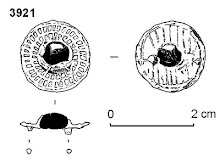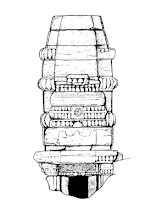Evaluation
work is continuing at Minories. So far the archaeological sequence is broadly
as predicted in LP Archaeology's desk based assessment, and we are now down to
mid 17th century levels in one trench, digging through levelling dumps containing lots of brick rubble.
The upper
surface of these dumps had been levelled out to form an external surface in the mid-late 17th century, with
a brick pier base suggesting a building that is not shown on Ogilby and Morgan's map of 1676. Ogilby and Morgan's mapping is known to be highly
accurate and is an excellent snapshot of the built environment in the late 17th
century, however the surveyors could not always access back yards and enclosed private
land, and the speed of building after the Great Fire means that some buildings
are missing -especially smaller or more temporary structures. The map is
however by far the best City-wide survey of London before the Ordnance Survey, and is
a fantastic resource for archaeologists and historians with accurate mapping of roads, yards and houses, as well as the contemporary street and place names.
There are tantalising glimpses of industrial
activity within the rubble dumps including glass making waste, crucible
fragments and slag, as well as Roman brick and opus signinum (which may or may not be from the adjacent Roman town
wall). Closely dateable clay tobacco pipes and ceramics should allow the
sequence of dumps and surfaces to be dated and the rate of the dumping worked
out -is this a single, orchestrated, episode of ground levelling intended to eradicate the
line of the former City Ditch, or a piece-meal and ongoing process? It is predicted that these dumps will seal late medieval/early post-medieval garden soils and external activity over the disused City ditch, with the disuse fills of the ditch buried beneath An adjacent borehole indicates these deposits extend to a further four metres depth from our current level, giving a total of just over 7.5m of deposits. Borehole evidence also suggests the presence of 'peaty' deposits within these fills, possibly preserved organic remains from refuse and waste dumped in the disused City ditch in the post-medieval period.













No comments:
Post a Comment